
|
You entered: solar flare
 International Space Station Trail
International Space Station Trail
14.12.2000
Still under construction, the International Space Station is literally becoming one of the brightest, fastest moving stars in the heavens. Despite illuminated clouds and bright light from a nearly full moon (lower left), this...
 Bright Sun and Crescent Earth from the Space Station
Bright Sun and Crescent Earth from the Space Station
30.11.2009
This was just one more breathtaking view from the International Space Station. The Sun, a crescent Earth, and the long arm of a solar panel were all visible outside a window when the Space Shuttle Atlantis visited the orbiting outpost last week. Reflections from the window and hexagonal lens flares from the camera are superposed.
 Sunspot Castle
Sunspot Castle
12.11.2011
Each day can have a beautiful ending as the Sun sets below the western horizon. This week, the setting Sun added naked-eye sunspots to its finale, as enormous active regions rotated across the dimmed, reddened solar disc.
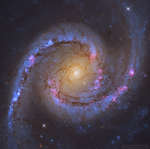 NGC 1566: The Spanish Dancer Spiral Galaxy
NGC 1566: The Spanish Dancer Spiral Galaxy
2.07.2019
If not perfect, then this spiral galaxy is at least one of the most photogenic. An island universe containing billions of stars and situated about 40 million light-years away toward the constellation of the Dolphinfish (Dorado), NGC 1566 presents a gorgeous face-on view.
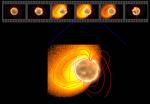 Galactic Magnetar Throws Giant Flare
Galactic Magnetar Throws Giant Flare
21.02.2005
Was the brightest Galactic blast yet recorded a key to connecting two types of celestial explosions? Last December, a dense sheet of gamma rays only a few times wider than the Earth plowed through our Solar System, saturating satellites and noticeably reflecting off the Moon.
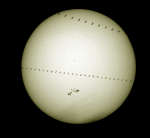 ISS Double Transit
ISS Double Transit
12.09.2015
Not once, but twice the International Space Station transits the Sun on consecutive orbits of planet Earth in this video frame composite. The scene was captured on August 22 from a single well-chosen location in Schmalenbeck, Germany where the ISS created intersecting shadow paths only around 7 kilometers wide.
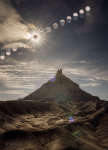 APOD: 2023 November 1 Б Annular Solar Eclipse over Utah
APOD: 2023 November 1 Б Annular Solar Eclipse over Utah
1.11.2023
Part of the Sun disappeared earlier this month, but few people were worried. The missing part, which included the center from some locations, just went behind the Moon in what is known as an annular solar eclipse. Featured here is an eclipse sequence taken as the Moon was overtaking the rising Sun in the sky.
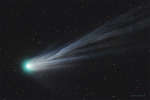 APOD: 2024 March 26 Б Comet Pons Brooks Ion Tail
APOD: 2024 March 26 Б Comet Pons Brooks Ion Tail
26.03.2024
Comet Pons-Brooks has quite a tail to tell. First discovered in 1385, this erupting dirty snowball loops back into our inner Solar System every 71 years and, this time, is starting to put on a show for deep camera exposures.
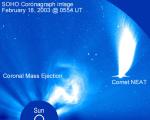 Comet NEAT Passes an Erupting Sun
Comet NEAT Passes an Erupting Sun
24.02.2003
As Comet NEAT flared last week, the Sun roared. Just as the comet swooped inside the orbit of Mercury and developed a long and flowing tail of gas and dust, the Sun emitted a huge Coronal Mass Ejection (CME).
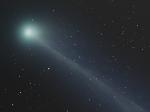 The Ghostly Tail of Comet SWAN
The Ghostly Tail of Comet SWAN
6.11.2006
What causes the structure in Comet SWAN's tail? Comet SWAN, which unexpectedly flared up to naked-eye brightness last week, has been showing detail in its ion tail that might be described as ghostly.
|
January February March April |
|||||||||||||||||||||||||||||||||||||||||||||||||